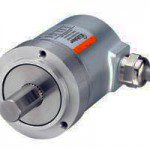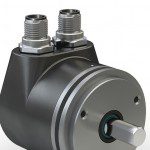Kübler is expanding its portfolio in the area of absolute multiturn encoders. The new Sendix M36 Series of magnetic multiturn encoders is complemented by an extremely robust variant. The harsh environment of mobile automation, wind power plants and maritime applications places particularly high demands on sensors. Sensors must withstand shocks, vibrations and temperature fluctuations. They […]
Absolute Encoders
Absolute ring encoder for angular motion feedback from HEIDENHAIN
HEIDENHAIN has introduced the next generation of their ERA 4000 incremental ring encoder, the ECA 4000 which includes absolute technology. With the ability to provide a direct upgrade path for existing ERA 4000 applications as well as new applications, HEIDENHAIN’s new ECA 4000 absolute series ring encoder offers several benefits and features for angular motion […]
Absolute redundant rotary encoder tracks angles and paths
By Mathias Roth, Branch Manager of Mobile Automation at SIKO • Edited by Lisa Eitel || Safety guidelines for mobile machines and their requirements have always influenced new mobile-machine builds. Now with the release of EN ISO 13849, new rules dictate how to reliably record angles and displacements. In fact, draft standards such as EN 13000 for mobile cranes […]
FAQ: What are traditional and newer multi-turn measuring systems for encoders?
Edited by Zak Khan || Multi-turn measuring encoders are absolute encoders that can count multiple turns. Three main technologies enable such encoder design — batteries, gearing, and self-powering setups. Batteries and gears are traditional implementations of multi-turn technology; self-powering setups are newer. Batteries: Simple but incur replacement costs Batteries maintain power supply even during machine […]
Ways to wire an absolute encoder into a motion system
Absolute encoders are traditionally wired in one of three ways: in parallel, with a serial interface, or over a bus. The serial and bus interfaces have multiple protocols or standards, some of which are open-source, while others are proprietary to specific manufacturers. When considering how to wire an absolute encoder, the required resolution, level of […]
FAQ: How do magnetic encoders work?
Encoders, whether rotary or linear, absolute or incremental, typically use one of two measuring principles—optical or magnetic. While optical encoders were, in the past, the primary choice for high resolution applications, improvements in magnetic encoder technology now allow them to achieve resolutions down to one micron, competing with optical technology in many applications. Magnetic technology […]
What are capacitive encoders and where are they suitable?
Two types of encoders dominate the general industrial market—optical and magnetic. But capacitive encoders, a relatively new introduction, offer resolution comparable to optical devices, with the ruggedness of magnetic encoders. Currently, there are only a handful of vendors for capacitive encoders, but their suitability for applications requiring high precision and durability make them a good […]
FAQ: What’s the difference between single and multi-turn rotary encoders?
Absolute rotary encoders output precise position information—even after a power-off condition—by assigning a unique digital value, or “word,” to each shaft position. But in applications where the encoder makes more than one revolution during the process, there is no way to know how many turns it has completed. At least not with the traditional type […]
Resolver versus encoder — what’s the difference?
Resolvers and encoders are both devices that measure the rotary position of a shaft by converting mechanical motion into an electrical signal. Resolvers have a longer history, originally used in military applications and adopted for industrial use due to their rugged design. But encoders are taking the place of resolvers in many applications. What’s driving the shift […]
Linear encoder types — and parameters for selection
Linear encoders monitor linear movement and provide position feedback in the form of electrical signals. In servo driven systems, linear encoders supply the precise position of the load, typically in addition to the speed and direction feedback provided by the motor’s rotary encoder. For stepper driven systems, which typically operate in open-loop mode with no position […]











